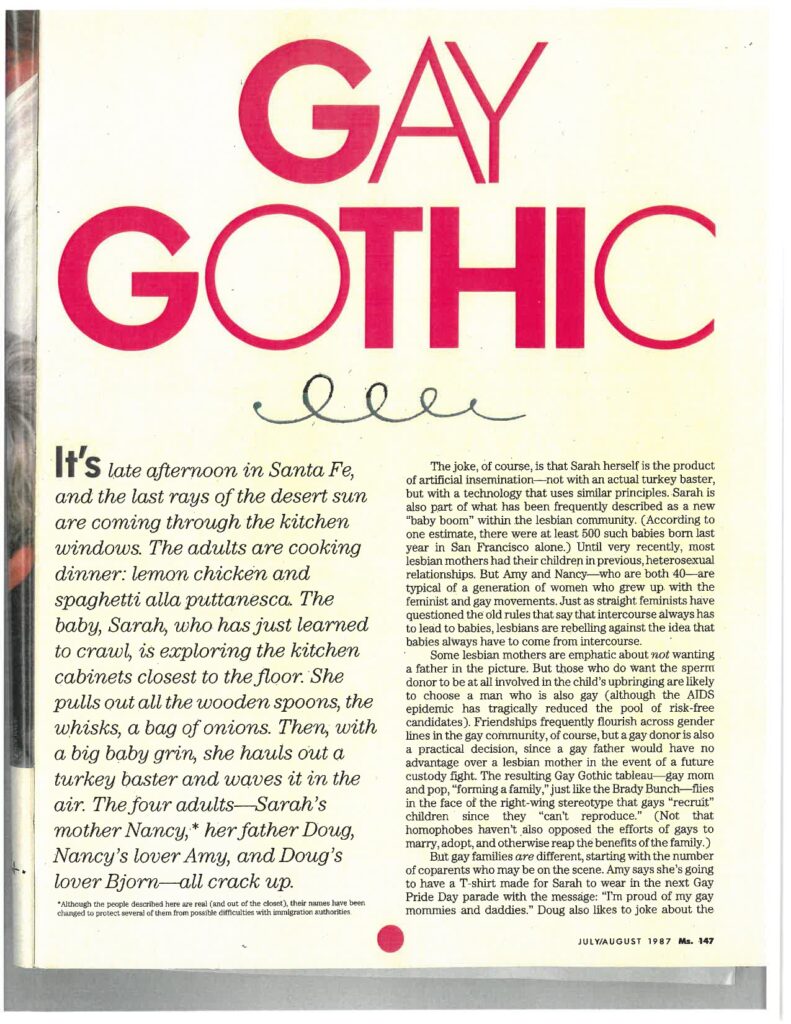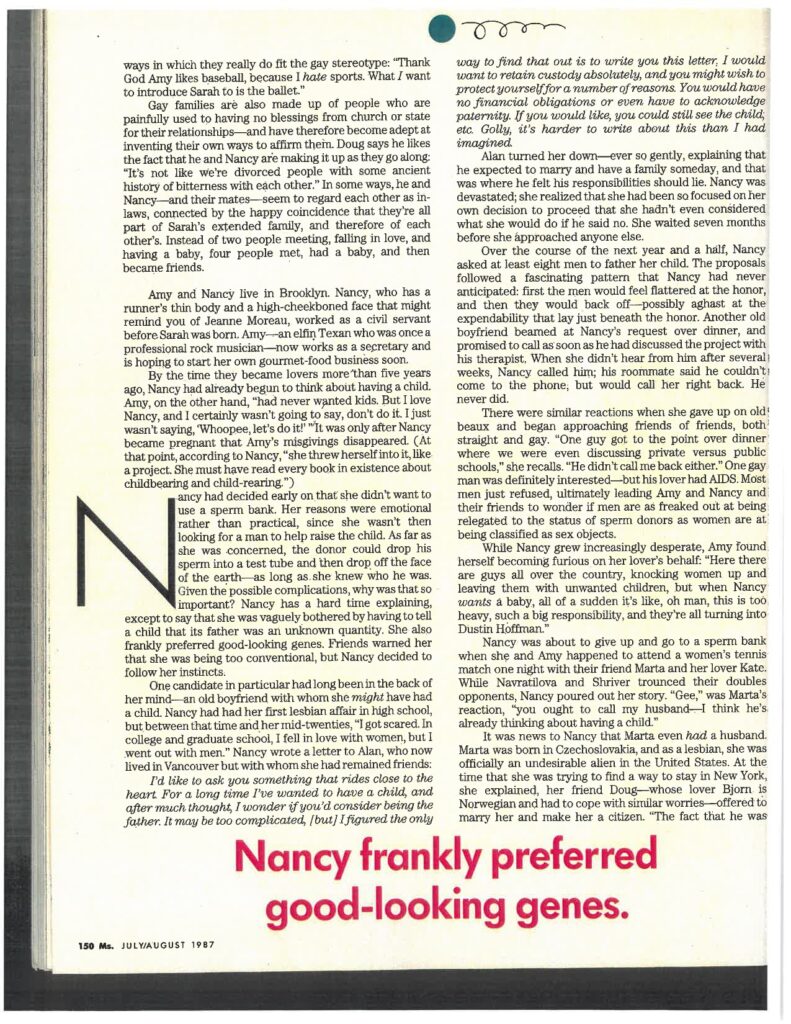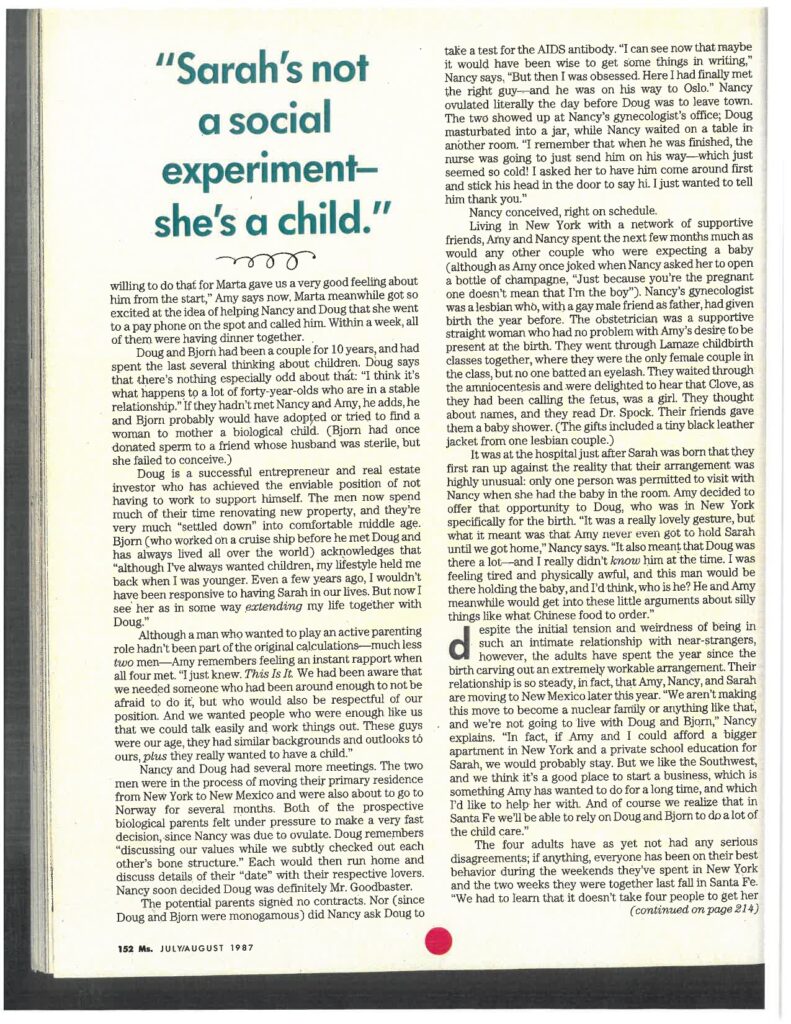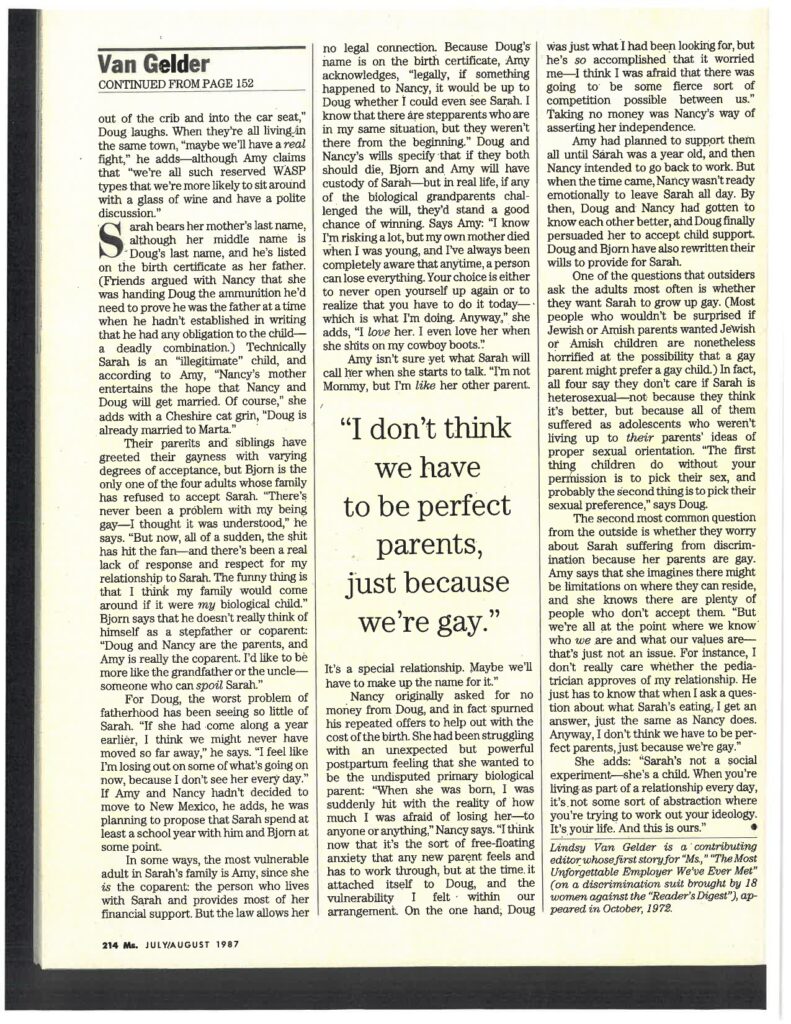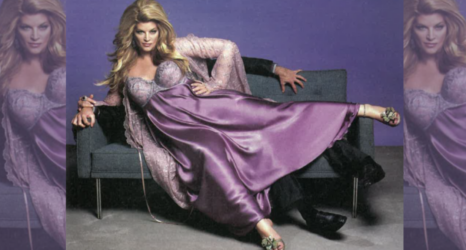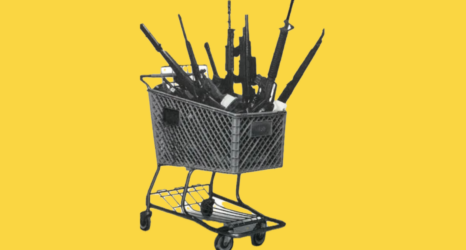
To pay tribute to five decades of reporting, rebelling and truth-telling, From the Vault includes some of our favorite feminist classics from the last 50 years of Ms. For more iconic, ground-breaking stories like this, order 50 YEARS OF Ms.: THE BEST OF THE PATHFINDING MAGAZINE THAT IGNITED A REVOLUTION (Alfred A. Knopf)—a stunning collection of the most audacious, norm-breaking coverage Ms. has published.
From the July/August 1987 issue of Ms. magazine:
It’s late afternoon in Santa Fe, and the last rays of the desert sun are coming through the kitchen windows. The adults are cooking dinner: lemon chicken and spaghetti alla puttanesca. The baby, Sarah, who has just learned to crawl, is exploring the kitchen cabinets closest to the floor. She pulls out all the wooden spoons, the whisks, a bag of onions. Then, with a big baby grin, she hauls out a turkey baster and waves it in the air. The four adults—Sarah’s mother Nancy,* her father Doug, Nancy’s lover Amy, and Doug’s lover Bjorn—all crack up.
The joke, of course, is that Sarah herself is the product of artificial insemination—not with an actual turkey baster, but with a technology that uses similar principles. Sarah is also part of what has been frequently described as a new “baby boom” within the lesbian community. Until very recently, most lesbian mothers had their children in previous, heterosexual relationships. But Amy and Nancy—who are both 40—are typical of a generation of women who grew up with the feminist and gay movements. Just as straight feminists have questioned the old rules that say that intercourse always has to lead to babies, lesbians are rebelling against the idea that babies always have to come from intercourse.
Some lesbian mothers are emphatic about not wanting a father in the picture. But those who do want the sperm donor to be at all involved in the child’s upbringing are likely to choose a man who is also gay (although the AIDS epidemic has tragically reduced the pool of risk-free candidates). The resulting Gay Gothic tableau—gay mom and pop “forming a family,” just like the Brady Bunch—flies in the face of the right-wing stereotype that gays “recruit” children since they “can’t reproduce.”
But gay families are different, starting with the number of coparents who may be on the scene. Amy says she’s going to have a T-shirt made for Sarah to wear in the next Gay Pride Day parade with the message: “I’m proud of my gay mommies and daddies.”
Gay families are also made up of people who are painfully used to having no blessings from church or state for their relationships—and have therefore become adept at inventing their own ways to affirm them. Doug says he likes the fact that he and Nancy are making it up as they go along: “It’s not like we’re divorced people with some ancient history of bitterness with each other.”
In some ways, he and Nancy—and their mates—seem to regard each other as in-laws, connected by the happy coincidence that they’re all part of Sarah’s extended family, and therefore of each other’s. Instead of two people meeting, falling in love, and having a baby, four people met, had a baby, and then became friends.
Amy and Nancy live in Brooklyn. Nancy, who has a runner’s thin body and a high-cheekboned face that might remind you of Jeanne Moreau, worked as a civil servant before Sarah was born. Amy—an elfin Texan who was once a professional rock musician—now works as a secretary and is hoping to start her own gourmet-food business soon.
By the time they became lovers more than five years ago, Nancy had already begun to think about having a child. Amy, on the other hand, “had never wanted kids. But I love Nancy, and I certainly wasn’t going to say, don’t do it. I just wasn’t saying, ‘Whoopee, let’s do it!’” It was only after Nancy became pregnant that Amy’s misgivings disappeared.
Nancy had decided early on that she didn’t want to use a sperm bank. Her reasons were emotional rather than practical, since she wasn’t then looking for a man to help raise the child. As far as she was concerned, the donor could drop his sperm into a test tube and then drop off the face of the earth—as long as she knew who he was. Given the possible complications, why was that so important? Nancy has a hard time explaining, except to say that she was vaguely bothered by having to tell a child that its father was an unknown quantity. She also frankly preferred good-looking genes. Friends warned her that she was being too conventional, but Nancy decided to follow her instincts.
Over the course of the next year and a half, Nancy asked at least eight men to father her child. The proposals followed a fascinating pattern: First, the men would feel flattered at the honor. Then they would back off—possibly aghast at the expendability that lay just beneath the honor. An old boyfriend beamed at Nancy’s request over dinner, and promised to call as soon as he had discussed the project with his therapist. When she didn’t hear from him after seven weeks, Nancy called him; his roommate said he couldn’t come to the phone, but would call her right back. He never did.
There were similar reactions when she gave up on old beaux and began approaching friends of friends, both straight and gay.
“One guy got to the point over dinner where we were even discussing private versus public schools,” she recalls. “He didn’t call me back either.” Ultimately Amy and Nancy and their friends began to wonder if men are as freaked out at being relegated to the status of sperm donors as women are at being classified as sex objects.
Nancy was about to give up and go to a sperm bank when she and Amy happened to attend a women’s tennis match one night with their friend Marta and her lover Kathy. While Navratilova and Shriver trounced their doubles opponents, Nancy poured out her story.
“Gee,” was Marta’s reaction, “you ought to call my husband—I think he’s already thinking about having a child.”
It was news to Nancy that Marta even had a husband. Marta was born in Czechoslovakia, and as a lesbian, she was officially an undesirable alien in the United States. At the time that she was trying to find a way to stay in New York, her friend Doug—whose lover Bjorn was Norwegian and had to cope with similar worries—offered to marry her and make her a citizen. “The fact that he was willing to do that for Marta gave us a very good feeling about him from the start,” Amy says now. Within a week, all of them were having dinner together.
Doug and Bjorn had been a couple for 10 years, and had spent the last several thinking about children. “I think it’s what happens to a lot of forty-year-olds who are in a stable relationship,” Doug says. If they hadn’t met Nancy and Amy, he adds, he and Bjorn probably would have adopted or tried to find a woman to mother a biological child.
Although a man who wanted to play an active parenting role hadn’t been part of the original calculations—much less two men—Amy remembers feeling an instant rapport when all four met. “We had been aware that we needed someone who had been around enough to not be afraid to do it, but who would also be respectful of our position. And we wanted people who were enough like us that we could talk easily and work things out.”
Nancy and Doug had several more meetings. The two men were in the process of moving their primary residence from New York to New Mexico and were also about to go to Norway for several months. Both of the prospective biological parents felt under pressure to make a very fast decision, since Nancy was due to ovulate. Doug remembers “discussing our values while we subtly checked out each other’s bone structure.” Each would then run home and discuss details of their “date” with their respective lovers. Nancy soon decided Doug was definitely Mr. Goodbaster.
Nancy ovulated literally the day before Doug was to leave town. The two showed up at Nancy’s gynecologist’s office; Doug masturbated into a jar, while Nancy waited on a table in another room.
Nancy conceived, right on schedule. Nancy’s gynecologist was a lesbian who, with a gay male friend as father, had given birth the year before. The obstetrician was a supportive straight woman who had no problem with Amy’s desire to be present at the birth. They went through Lamaze childbirth classes together, where they were the only female couple in the class, but no one batted an eyelash. They waited through the amniocentesis and were delighted to hear that Clove, as they had been calling the fetus, was a girl. They thought about names, and they read Dr. Spock. Their friends gave them a baby shower.
It was at the hospital just after Sarah was born that they first ran up against the reality that their arrangement was highly unusual: Only one person was permitted to visit with Nancy when she had the baby in the room. Amy decided to offer that opportunity to Doug, who was in New York specifically for the birth.
“It was a really lovely gesture, but what it meant was that Amy never even got to hold Sarah until we got home,” Nancy says. “It also meant that Doug was there a lot—and I really didn’t know him at the time. I was feeling tired and physically awful, and this man would be there holding the baby, and I’d think, who is he? He and Amy meanwhile would get into these little arguments about silly things like what Chinese food to order.”
Despite the initial tension and weirdness of being in such an intimate relationship with near-strangers, the adults have spent the year since the birth carving out an extremely workable arrangement. Their relationship is so steady, in fact, that Amy, Nancy and Sarah are moving to New Mexico later this year.
“We aren’t making this move to become a nuclear family and we’re not going to live with Doug and Bjorn,” Nancy explains. “In fact, if Amy and I could afford a bigger apartment in New York and private school education for Sarah, we would probably stay. But we like the Southwest and of course we realize that in Santa Fe we’ll be able to rely on Doug and Bjorn to do a lot of the child care.”
Sarah bears her mother’s last name, although her middle name is Doug’s last name, and he’s listed on the birth certificate as her father. (Friends argued with Nancy that she was handing Doug the ammunition he’d need to prove he was the father at a time when he hadn’t established in writing that he had any obligation to the child—a deadly combination.)
In some ways, the most vulnerable adult in Sarah’s family is Amy, since she is the coparent: the person who lives with Sarah and provides most of her financial support. But the law allows her no legal connection. Because Doug’s name is on the birth certificate, Amy acknowledges, “legally, if something happened to Nancy, it would be up to Doug whether I could even see Sarah. I know that there are stepparents who are in my same situation, but they weren’t there from the beginning.”
Doug and Nancy’s wills specify that if they both should die, Bjorn and Amy will have custody of Sarah—but in real life, if any of the biological grandparents challenged the will, they’d stand a good chance of winning. Says Amy: “I know I’m risking a lot, but my own mother died when I was young, and I’ve always been completely aware that any time, a person can lose everything. Your choice is either to never open yourself up again or to realize that you have to do it today.”
Amy isn’t sure yet what Sarah will call her when she starts to talk. “I’m not Mommy, but I’m like her other parent. It’s a special relationship. Maybe we’ll have to make up the name for it.”
Nancy originally asked for no money from Doug, and in fact spurned his repeated offers to help out with the cost of the birth. She had been struggling with an unexpected but powerful postpartum feeling that she wanted to be the undisputed primary biological parent: “When she was born, I was suddenly hit with the reality of how much I was afraid of losing her—to anyone or anything,” Nancy says. “I think now that it’s the sort of free-floating anxiety that any new parent feels and has to work through, but at the time it attached itself to Doug, and the vulnerability I felt within our arrangement.”
Amy had planned to support them all until Sarah was a year old, and then Nancy intended to go back to work. But when the time came, Nancy wasn’t ready emotionally to leave Sarah all day. By then, Doug and Nancy had gotten to know each other better, and Doug finally persuaded her to accept child support. Doug and Bjorn have also rewritten their wills to provide for Sarah.
One of the questions that outsiders ask the adults most often is whether they want Sarah to grow up gay. In fact, all four say they don’t care if Sarah is heterosexual—not because they think it’s better, but because all of them suffered as adolescents who weren’t living up to their parents’ ideas of proper sexual orientation.
“The first thing children do without your permission is to pick their sex, and probably the second thing is to pick their sexual preference,” says Doug.
Amy adds: “Sarah’s not a social experiment—she’s a child. When you’re living as part of a relationship every day, it’s not some sort of abstraction where you’re trying to work out your ideology. It’s your life. And this is ours.”
*Although the people described here are real (and out of the closet), their names have been changed to protect several of them from possible difficulties with immigration authorities.
Up next:
U.S. democracy is at a dangerous inflection point—from the demise of abortion rights, to a lack of pay equity and parental leave, to skyrocketing maternal mortality, and attacks on trans health. Left unchecked, these crises will lead to wider gaps in political participation and representation. For 50 years, Ms. has been forging feminist journalism—reporting, rebelling and truth-telling from the front-lines, championing the Equal Rights Amendment, and centering the stories of those most impacted. With all that’s at stake for equality, we are redoubling our commitment for the next 50 years. In turn, we need your help, Support Ms. today with a donation—any amount that is meaningful to you. For as little as $5 each month, you’ll receive the print magazine along with our e-newsletters, action alerts, and invitations to Ms. Studios events and podcasts. We are grateful for your loyalty and ferocity.



